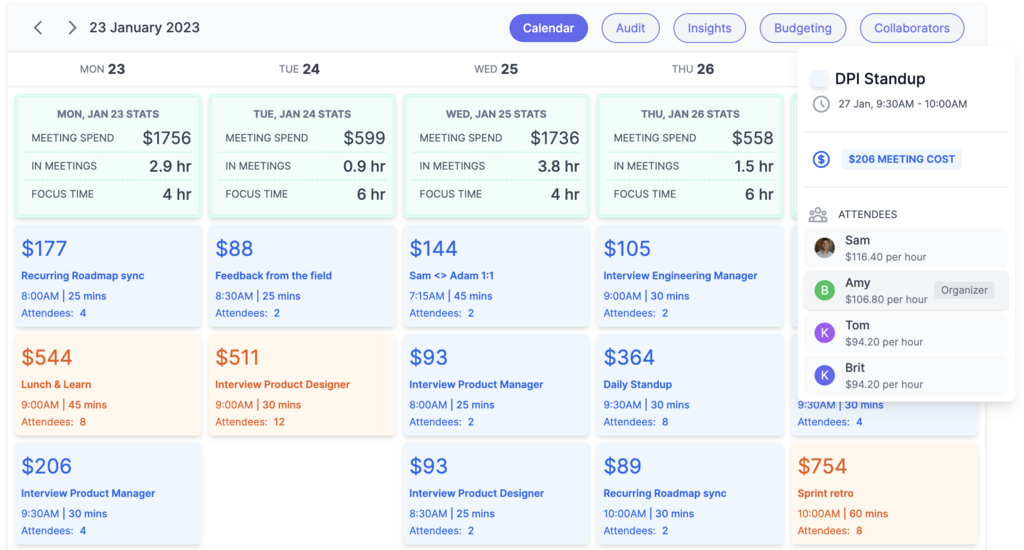The Real Cost of Meetings
May 13, 2023

Meetings. We’ve all been there. The time seems to slip away, one hour-long meeting after another. But have you ever stopped to consider the real cost of these meetings?
Let’s break it down:
If you’re in a tech company with an average 6-person meeting that lasts an hour, the cost is likely nearing $1000.
Surprised? You’re not alone.
Most people don’t realize just how expensive meetings can be. But how exactly do we arrive at this figure?
Decoding the Meeting Cost
The calculation is simpler than you might think.
Consider the hourly wage of each participant. Multiply that by the length of the meeting. Add up the cost for each participant, and voila, you have your meeting cost.
But that’s not all. Don’t forget to factor in the opportunity cost — the value of the work that could have been done in the time spent in the meeting.
So, the equation becomes:
Meeting Cost = (Hourly Wage x Meeting Duration x Number of Participants) + Opportunity Cost
The result? A stark realization that meetings are far more expensive than we tend to think.
Beyond these apparent costs, meetings carry hidden expenses that are often overlooked. These unspoken costs can compound the impact on your productivity, making your meetings even more expensive. Two such hidden costs are ‘fragmented time’ and ‘meetings without agendas.’
Fragmented Time: The Cost of Meeting Gaps
Have you ever had a day filled with meetings that are spaced out, leaving small gaps of time in between? These gaps, often too short for deep, focused work, can lead to what we call ‘fragmented time.’
While these gaps might seem like a break, they carry an unspoken cost. The transition time between tasks, or ‘context switching,’ can significantly impair your productivity. It can take upwards of 20 minutes to refocus after an interruption, meaning that these small gaps can lead to a significant waste of time and resources.
Meetings Without Agendas: The Productivity Trap
We’ve all been part of meetings that start without a clear purpose or agenda. These directionless discussions can lead to meandering conversations that seldom result in actionable outcomes.
The cost of these meetings is two-fold. On one hand, there’s the direct cost of the time spent in the meeting. On the other, there’s the cost of the missed opportunity to spend that time on productive tasks that drive towards your goals.
Timeback: Unmasking the Hidden Costs
This is where Timeback comes in. Timeback doesn’t just calculate the direct cost of your meetings, but it also helps uncover these hidden costs.
By analyzing your calendar data and work patterns, Timeback can identify fragmented time and provide insights on how to better structure your day for productivity.
It promotes a culture of respect for time, encouraging the practice of setting clear agendas before meetings and making them more effective.
The Outcome?
Transparency. Clarity. Control.
With Timeback, you’ll not only see where your time is going but also understand the full extent of how much your meetings are costing you.
Armed with these insights, you can make informed decisions to optimize your time. Maybe it’s time to batch your meetings together to reduce fragmented time. Or perhaps it’s about enforcing a rule for clear agendas before any meeting.
Remember, every minute counts, and with Timeback, you can make every minute work for you. It’s about making your meetings effective and productive. It’s about making sure your time aligns with your goals.
So, are you ready to take back control of your time and manage your meeting costs efficiently?
Try Timeback today and start unmasking the hidden costs of your meetings.
If you are interested in joining early and influencing the direction of Timeback:
- Sign up here for early access
- Follow our buildinpublic journey on Medium.
- Got something to add? Continue the conversation on Twitter!
Ready to Reclaim Your Time?
Connect your calendar once and let Timeback help you optimize your schedule, protect your focus time, and reduce meeting costs.
